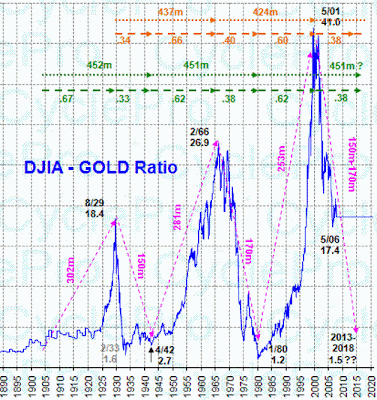Brokers Believe Worst Is Over and Recommend Buying of Real BargainsWall Street in looking over the wreckage of the week, has come generally to the opinion that high grade investment issues can be bought now, without fear of a drastic decline. There is some difference of opinion as to whether not the correction must go further, but everyone realizes that the worst is over, and that there are bargains for those who are willing to buy conservatively and live through the immediate irregularity.-- New York Herald Tribune, October 27, 1929
29 December 2007
The Great Crash of 1929 Redux
27 December 2007
Between Scylla and Charybdis: The Odyssey of Ben Bernanke

The Fed is doing a balancing act, and it has been doing so for some time, making its way from bubble to bubble through the uncharted waters of fiat-onomics, the monetary mythology.
On one hand is the US financial system breaking down with the economy in a deep recession. On the other hand is the US dollar and bond in freefall with inflation flying higher than Icarus with a tail wind.
Using a classical Greek metaphor, the Fed is navigating between the Scylla (Σκύλλα)of Recession and the Charybdis (Χάρυβδις) of Currency Debasement.
Greek mythology portrayed Charybdis as lying on one side of a narrow channel of water, which some think was the Strait of Messina. On the other side of the strait was Scylla. The two sides of the strait are within an arrow's range of each other, so close that sailors attempting to avoid Charybdis will pass too close to Scylla and vice versa.
The phrase between Scylla and Charybdis has come to mean being in a state where one is between two dangers and moving away from one will cause you to be in danger of the other. Between Scylla and Charybdis is the origin of the phrase between the rock and the whirlpool (the rock upon which Scylla dwelt and the whirlpool of Charybdis) and may be the genesis of the phrase "between a rock and a hard place".
Scylla is a horribly grotesque sea monster, with six long necks equipped with grisly heads, each of which contained three rows of sharp teeth. Her body consisted of twelve canine legs and a fish's tail.
Charybdis takes form as a monstrous mouth. She swallows huge amounts of water three times a day and then belches them back out again creating whirlpools. Charybdis was originally a naiad, sea-nymph who flooded land to enlarge her father's underwater kingdom, until Zeus turned her
 into a monster. He was angry that she was taking so much of his land and made it so that she would be incredibly thirsty three times a day and suck in the water.
into a monster. He was angry that she was taking so much of his land and made it so that she would be incredibly thirsty three times a day and suck in the water.In the Odyssey, the Argonauts were able to avoid both dangers because they were guided by Thetis, one of the Nereids.
Can Ben Bernanke find Thetis? Can he navigate through uncharted waters on the course that Greenspan has put us upon?
Charybdis Rears Its Ugly Head
Rate cuts will hammer dollar: Chinese official
Flight of capital seeking higher returns in Asia could depress dollar on further rate cuts, China says
December 27 2007: 7:28 AM ESTBEIJING (AP) -- Further cuts in U.S. interest rates would have a "harmful effect" on the dollar and the international finance system, a Chinese finance official wrote in a commentary Thursday in an official newspaper.The dollar's fall against many currencies has prompted investors to sell dollar-denominated assets, Hu Xiaolian, director of the State Administration of Foreign Exchange, wrote in the Financial News, a newspaper published by the central bank. "If the (U.S.) federal funds rate continues to fall, this will certainly have a harmful effect on the U.S. dollar exchange rate and the international currency system," Hu wrote. Financial markets closely watch official Chinese comments on the dollar because Beijing keeps a large portion of its $1.4 trillion in reserves in U.S. Treasury securities and any change in China's investment strategy could affect exchange rates. Despite his warning, Hu wrote, "the U.S. dollar's dominant position in international currency markets is unlikely to change in the near term. "The U.S. Federal Reserve has lowered its federal funds rate, the interest that banks charge each other for overnight loans, to 4.25 percent, a full percentage point lower than it was in September, to ease a credit crunch in the U.S. financial system. Chinese officials have said that cutting the rate could encourage investors to move money to Asia or elsewhere in search of better returns, which could depress the dollar.
23 December 2007
Recessions and the SP 500
 As the chart shows, once his KRWI reaches this critical level its a strong probability that we will see an economic recession call by the National Bureau of Economic Research (NBER). Even the period following the tech wreck of 2000 eventually read out a formal recession, although the financial engineering of the Fed and federal friends did block the traditional back to back quarters of economic contraction, as the inflation reading is subtracted from the nominal GDP number to develop real GDP. Hard as it may be to believe, the government has simply changed the rules of the game for measuring price inflation in the US, and considerably enough that what used to be a recession may no longer be called one. Changing the rules of the game is a traditional method of the privileged and elite in achieving their goals.
As the chart shows, once his KRWI reaches this critical level its a strong probability that we will see an economic recession call by the National Bureau of Economic Research (NBER). Even the period following the tech wreck of 2000 eventually read out a formal recession, although the financial engineering of the Fed and federal friends did block the traditional back to back quarters of economic contraction, as the inflation reading is subtracted from the nominal GDP number to develop real GDP. Hard as it may be to believe, the government has simply changed the rules of the game for measuring price inflation in the US, and considerably enough that what used to be a recession may no longer be called one. Changing the rules of the game is a traditional method of the privileged and elite in achieving their goals. Funds Rate) is still negative as of the Fed's official numbers last week.
Funds Rate) is still negative as of the Fed's official numbers last week.
So it bothers us quite a bit that the stock market, that great discounter of the future and unerringly efficient prognosticator of economic things yet unseen, is presumed to be rallying back to new all time highs, even if only on a nominal level, not accounting for inflation. We show the SP deflated by gold in this chart, and as you can see, the rebound in US stocks is a bit of a mirage. If the bad times are when the tide goes out and shows who's naked, then inflation is the hurricane storm surge that pushes the waters back in, to provide cover for those au naturel.
By the way, the perception of inflation, or inflation expectations, is not incidental, but rather is absolutely key to the kind of financial engineering that neo-Keynesian economists that infest the Fed and Treasury wish to embrace as the ripe fruits of a fiat monetary system. Don't think for one minute that what is happening with M3, CPI revisions, etc. are a mere coincidence. Its all about control of the many by the few, after all.

If in fact we are on the verge of a recession, the SP500 will likely be in the process of making a top. We might see another push higher by the broad stock indices in response to the unprecedented monetary stimulus being applied by the banks. But even with this latest phase in the financial engineering experienment currently in progress, within the next two months we should see a confirming signal from the equity markets that the economy is turning lower in real terms AND has started contracting, even if the current set of official economic measures say otherwise.
We underestimated the Fed and their banker buddies in the great reflation of 2003-2004, finally catching on to the game after some painful soul searching and genuine confusion. The July 2004 working paper from Small and Close of the Fed, which basically tried to set some boundaries in how far the Fed could go in monetizing things non-traditional was a good clue, well before the infamous speech about the Fed's printing press that gave Helicopter Ben his sobriquet.
So we will strive to not be fooled again, and keep an open mind that the fighting of the housing bubble and massive credit fraud by the banks could have a short term second order effect of inflating the stock markets, along with most other commodities, especially gold and oil. One thing we are certain is that the next twelve months may be among the most interesting we have seen, and can only wonder what we all might be saying about things at this time next year.































